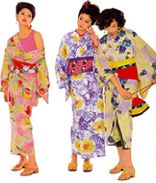|
Science & Technology || Sports & Fashion || Search || Back Numbers
OLD LOOK WITH A NEW TWIST: Casual Summer Kimonos Make a Comeback June 30, 1998  Hot colors and designs make for a cool look in summertime. (Horii Inc.) Modern-day Japanese women rarely wear kimonos except on special occasions. Over the past few years, however, casual light cotton kimonos known as yukata have made a comeback as everyday dress during the summer. Yukata are expected to be just as popular this summer, with several new variations, including those resembling a slit skirt with matching tops, and yukata made of sheer fabric (worn with slips, of course). New Styles Made a Splash in 1989 Traditionally, yukata had been one type of kimono that could be worn casually--after a bath or on steamy summer nights, for example. As Japan modernized, however, kimonos fell out of fashion for everyday use, and the popularity of yukata swiftly declined. Western clothes--T-shirts with jeans, tank tops with shorts--became the preferred casual wear. Around 1989, however, new variations of yukata began hitting the market, prompting young women to take a fresh look at this time-honored garment. Previously, most yukata had been made of navy-and-white fabric decorated with traditional Japanese patterns. In 1989, however, popular Japanese fashion designers came out with yukata in brighter, Western-inspired colors and patterns. In the past, women had yukata made to order from fabric they purchased themselves. But when they saw ready-made yukata in retail settings, they began thinking of these garments as finished clothing, and this new perspective sparked a realization: "Hey! There are cute clothes that come from right here in Japan!" And so yukata caught on in a big way.
This is not to say that traditional Japanese designs have been completely abandoned. In 1997 young people went back to the fabrics and patterns of older clothes; the craze extended beyond yukata to include blouses, dresses, and bags made from yukata fabric. Geta (traditional Japanese wooden-soled thong sandals) worn with Western clothing became a popular combination as well. The yukata season is upon us once more, and in addition to the new designs decribed above, easier-to-wear variants are also coming out. For example, some yukata now have the traditional midriff tuck sewn into place. (Traditionally, wearers tuck the extra fabric around the midsection to adjust the hemline and tie a sash over it to hold it in place.) The variety of footwear and accessories designed to complement yukata is also growing. Mules, or sandals with heels, are currently in vogue, and now there are mules with geta thongs. Also on the market are geta inspired by the "massage sandals" popular in Japan. Handbag options include not only see-through tote bags made of nylon or mesh, but also Japanese-style bags with nontraditional patterns. Women will surely keep finding even more different ways to wear yukata. Department stores are hosting yukata fashion shows and heating up their sales campaigns with an eye to July and August, the heart of the yukata season.
 Edited by Japan
Echo Inc. based on domestic Japanese news sources. Articles
presented here are offered for reference purposes and do not
necessarily represent the policy or views of the Japanese
Government. Edited by Japan
Echo Inc. based on domestic Japanese news sources. Articles
presented here are offered for reference purposes and do not
necessarily represent the policy or views of the Japanese
Government.
|
